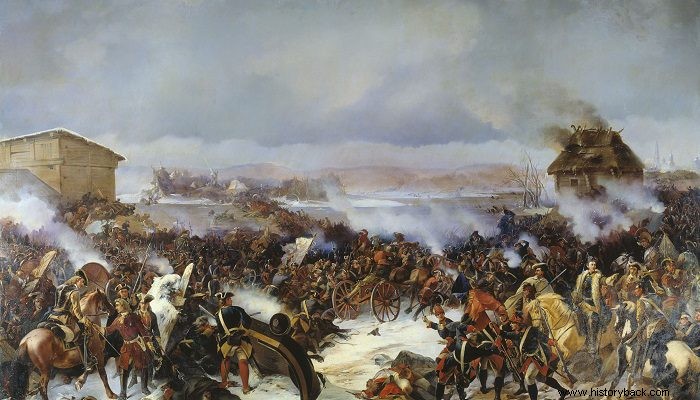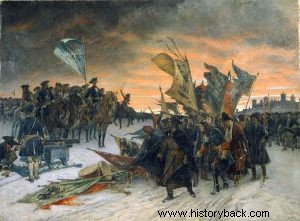
The Battle of Narva was the first major battle of the Great Northern War. In this war, Sweden was fighting alone against huge Russia, its traditional rival Denmark and the united Poland-Saxony.
The Russian Tsar Peter the Great had tried to make his still medieval country a modern European power. For this purpose, however, he had to face the power that controlled the Baltic, Sweden.
Thus he joined the anti-Swedish coalition despite the fact that his forces were not yet at their best quality. In 1700 the tsar raised 31 new infantry regiments, based on European standards. However, an army is much more than uniforms and the ability to march.
On the other hand, Sweden was fortunate to have two power multipliers. A small but highly trained and staffed army that religiously followed its king into battle, and a royally born warrior, Charles XII.
Charles ascended the throne at the age of 15 and showed his military talent. Fearless, believing that whatever was happening was the will of God, he defied the numerical superiority of his opponents and their fire. And he managed to instill the same spirit in his men.
At the battle of Narva he was only 18 years old. Charles found himself at this young age faced with situations that would have made rulers much older than him to be defeated. But he reacted in a flash and with lightning strikes put Denmark out of the war.
Undeterred from the west, he turned towards the East, landing in Estonia. There the situation was also grim. Strong Russian forces were besieging the city of Narva north of the famous Lake Peipus. The city's garrison consisted of only 1,800 men, while the Russian forces besieging it exceeded 37,000 men and had 195 cannons.
Charles managed to muster only 10,500 men and 37, mostly light, guns. Charles personally commanded his small army assisted by Lt. General Carl Gustav Renskjold and General Otto Walling, both experienced warriors with extensive action.
The Russian forces were commanded by the tsar, who, however, a day before the battle, withdrew, leaving the German, of French origin, Karl de Croy and Antonom Golovin, Ivan Trumbetskoi, Adam Weide and Boris Sheremetev in command.
To this day, historians argue about the reason for Tsar Peter's departure. Most argue that he did not expect Charles's small forces to attack and left with the intention of returning with reinforcements. Others accuse him of cowardice, which is probably not the case. The important thing is that the tsar's departure on the eve of the battle was not the best morale booster for his men.
Also, Petros did not leave alone but together with his second in command, Marshal Fyodor Golovin. It is worth noting that de Croix did not want to take command but was pressured by the tsar.
The Russian army was divided into three divisions each commanded by Golovin, Trumbetskoi and Weide. All three were young favorites of the tsar, aged 23, with little military experience. The more experienced Sheremetev commanded non-regular units of boyar (noble) horsemen. Also in command of the numerically strong Russian artillery was the also young, completely inexperienced military favorite of the Tsar, Prince Alexander Imereti.
Powers and arrangement
On the evening of November 29, 1700, Charles with his small army had arrived at the village of Lagena, approximately 13 km from Narva. Charles did not know whether the garrison was still holding or whether the city had surrendered to the Russians.
The young Swedish king, austere, oligarchic and well-liked by his men, inspected his forces and sent out cavalry patrols to investigate the situation. If the city still held he would be alerted by cannonading. So it happened. However, due to the cannon fire, the Russians realized that the enemy was approaching.
Immediately de Croy put his forces on the alert. The Russians kept half their forces in readiness throughout the night. At first light de Croix ordered his entire army into battle along the defensive ditch and positions they had dug around the city.
Due to the inexperience of his men he ordered no regiment to open fire on the Swedes before they approached within 15-20 m. It is worth noting that the Swedes practiced a very aggressive tactical doctrine called "Ga Pa" which in free rendering it is translated as "upon them".
Their infantry, 1/3 of which were equipped with sarissas, galloped up to the enemy, unleashed a salvo at him from a distance of 20 m, and then charged with their sarrisas and bayonets against him with yaks. The Swedes marched into battle chanting psalms and before the battle recited the "Our Father".
The next day the Swedes moved first. The men had gathered bundles of wood with which to fill the trench the Russians had dug around their positions. The Russian forces were expecting the enemies.
When de Cory saw Charles' small army he thought it was only the Swedish vanguard. Believing that Charles had other forces at his disposal, he refused Sheremetev's proposal that the army leave the trenches and face the enemy in an open field.
The Russian army was deployed in two lines each 6.5 km long between two lines of battle positions. In this way the Russian army could not even maneuver. In the center of the Russian line a strong point had been established on Goldenhof Hill.
Charles seeing the Russian formation decided to ignore the Russian strongpoint and attack left and right of the Russian line, throwing 10 infantry battalions into the battle in each direction. The front guard was made up of elite grenadiers.
The Swedish battalions had an average strength of only 300 men. The cavalry numbering about 4,500 men covered the flanks of the infantry. But his main mission was to prevent the Russians from leaving their strongholds. And the 37 guns of the Swedes lined up on an artillery hill and bombarded the pre-selected points of the Russian formation where the infantry would attack.
The battle
At 14.00 the Swedes were ready and their advance began. At that moment a blizzard broke out. Charles saw a golden opportunity against his officers who suggested he postpone the attack. The Swedes, following the "Ga Pa" tactic, got within striking distance, unleashed a murderous volley, sweeping the first Russian yokes and charging at the enemy with yaches.
The Russians returned fire but within minutes the Swedes were upon them. A savage massacre ensued. The flanks of the Russian line "broke". The forces in the center of their formation could neither fight, nor retreat, nor maneuver.
Chaos and panic ensued. The Russian soldiers killed their officers, especially the foreigners, and fled. The panic-stricken Russians attempted to cross the bridge over the Narova River, which formed the rear end of their position, but the bridge collapsed under the weight and thousands were trampled, or perished in the icy water.
Only two regiments of the tsar's guard fought well. They formed a large square and held the Swedes. Charles who personally led the charge against them was lucky to survive as his horse was killed. In the end, however, they could not hold out indefinitely and were forced to capitulate.
All the Russian generals, except Sheremetev, were captured . The battle had ended in triumph for the small Swedish army and its excellent commander. The Russians lost a total of 18,000 men and 173 guns. The Swedes had 667 dead and 1,247 wounded.
Unfortunately for himself, Charles was unable to take advantage of his success, both because of the winter and because he had to deal with both the Poles and the Saxons. Thus he was forced into a long struggle, finally meeting his fate in Poltava, nine years later.

Russian flags booty in the hands of the victorious Swedes.
